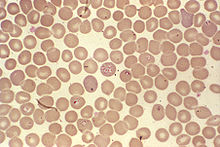Babesiosis causes: Difference between revisions
Jump to navigation
Jump to search
| Line 20: | Line 20: | ||
==Etymology and pronunciation== | ==Etymology and pronunciation== | ||
* Babesia was named after Victor Babes, the physician and scientist who originally discovered the parasite as the primary culprit in the hemolytic illness, Babesiosis. | |||
==Cause of Babesiosis infection== | ==Cause of Babesiosis infection== | ||
Revision as of 21:04, 10 December 2015
Overview
Babesiosis is caused by apicomplexan parasitic organism within the genus Babesia. B. Microti and B. divergens are the two species of Babesia that have been frequently reported as parasitic within human populations. Babesia parasites reproduce in red blood cells, where they can be seen as cross-shaped inclusions (4 merozoites asexually budding but attached together forming a structure looking like a "Maltese Cross") and cause hemolytic anemia, quite similar to malaria.
Organism
- The genus babesiidae hosts over 100 species of Babesia. However, Babesia Microti (B.Microti) and Babesia Divergens (B. Divergens) are most frequently reported as the apicomplexan parasitic organisms responsible for causing human infections (Babesiosis.)
- Babesia are transmitted through a Tick vector, most notably the Ixodidae tick family.
Human pathogen
Strains
Genome
Bacteriophage
Etymology and pronunciation
- Babesia was named after Victor Babes, the physician and scientist who originally discovered the parasite as the primary culprit in the hemolytic illness, Babesiosis.
Cause of Babesiosis infection
Gallery
